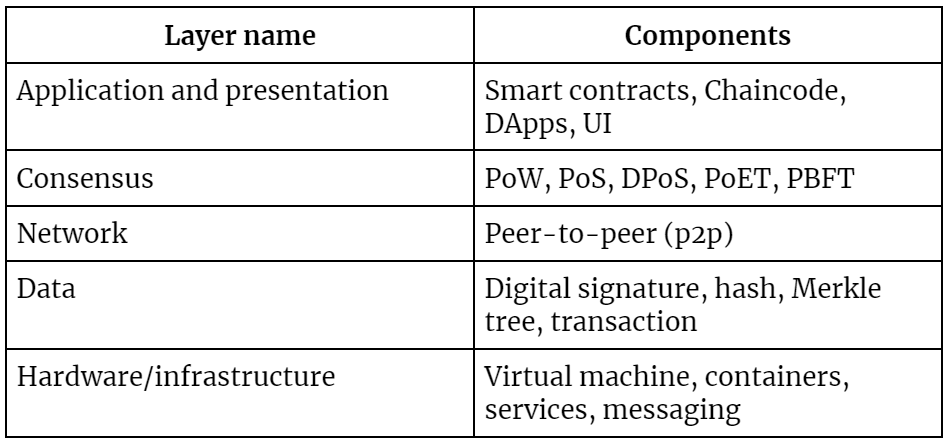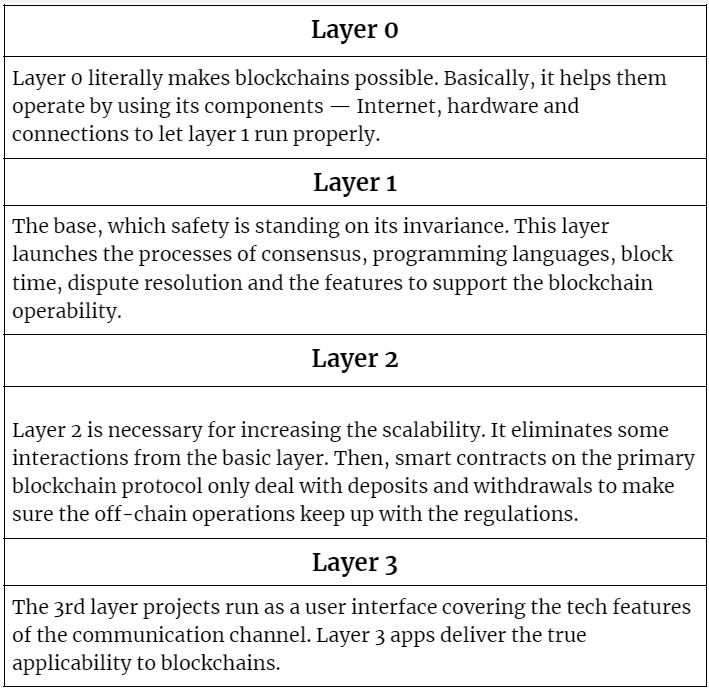The Layers Of Blockchain

This blog post will cover:
- Blockchain scalability explained
- Layered structure
- Layers 0-3 explained
- Conclusion
Both crypto and blockchain technologies are getting more popular each year. Now when you ask somebody if he or she has heard of these terms, they’ll rather say “yes” than “never”.
However, the mass knowledge isn’t deep enough, just a few people can explain how the blockchain works. This happens because most people think it’s too complicated, and you need to be a specialist to understand how the mechanism operates.
Today we’re here to make it simple for you and show that it’s possible to dive into blockchain technology without any special education. Let’s go!
Blockchain scalability explained
The definition of scalability mostly depends on the expert who is trying to explain it. But all in all, it’s a capability of the system to provide a comfortable experience to people anytime, no matter how many people are there. This leads us to the throughput term — quantity of transactions accomplished by a system per one second (TPS).
For example, VisaNet e-payment handles more than 1,700 TPS while the BTC chain only copes with 7 TPS. However, many crypto projects do show better results — for example, Solana (SOL) with its 3,000 TPS, or Ripple (XRP) with 1,500 TPS. We have recently discussed Visa's updates. You can read about its plans to launch Metaverse, crypto wallets and even NFTs here.
Blockchain appears to be the 1st layer. The second one is the inclusion of the 3rd party to add more nodes, in order to make the throughput better. In fact, smart contracts make this happen, too.
Layered structure
Because of the decentralization, transactions are secured and the information is kept on a distributed ledger which users can get access to. This ledger system uses a prearranged protocol, it needs a consensus to be reached by various nodes to confirm the transaction data. Every node endlessly appends, checks and edits fresh entries.
All the above said is possible because of the layers:

Now let’s take a closer look at each one to explore the features.
Hardware and infrastructure layer
The data could be kept on separate nodes or a server. A blockchain is a p2p computer network for confirming and recording transactions inside of the shared ledger.
Users get a chance to interact straightly and even share data. A p2p network is actually a big computer network which exchanges data. Therefore all the information and operations are held in a distributed base.
Data layer
The arrangement of the data is characterized as an ordered connected list of blocks. The core things of this structure are pointers and a connected list. Transactions are signed to assure the privacy of the data that exist in the layers. They’re usually signed by a private key, and those who sign might be confirmed by users who own a public key.
The electronic signature inspects the unity and looks for info modification. The data is encoded with a special hash which means it can’t be falsified. The ID of the transmitter or owner is covered too so it’s hard to identify them. The signature is irreversibly tied to the person who owns it and can’t be neglected.

Network layer
It’s a place where the nodes are able to communicate. Its duty is to manage the transactions and reproduction of the blocks. It ensures that nodes can share info and sync to support the wholeness of the whole network. In a p2p network, nodes are distributed and split the network workload.
Consensus layer
The significant piece of the network which lets blockchain platforms run properly. Due to it, all blocks are placed in order and are confirmed. An exact number of deals between nodes are defined by this layer. It has special rules that nodes need to stick to verify transactions and make blocks. In turn, the rules depend on the consensus type, which was agreed on in the network. Thus, transactions could be verified by those who’s actively staking. The main point is that nobody can totally control the blockchain since it keeps power decentralized. You may read more about PoW and PoS consensus algorithms here.
Application and presentation layer
It’s created from dApps, smart contracts and a chain code. It includes software which consumers utilize for interacting with the network. It has app programming and user interfaces, scripts and frameworks in it. Technically, the blockchain is a back-end system for these apps, and they interact via APIs.
Even though a transaction shifts from the application to the execution layer, it’s confirmed and performed at the semantic layer. Applications provide guidelines to the execution layer, which accomplishes transactions and helps to maintain the deterministic nature of blockchain.
Layers 0-3 explained
Don’t forget about 3 basic layers. Let’s see what they are meant for in the blockchain mechansm.

What’s the key difference between layers 1 and 2? The blockchain is the 1st layer. Layer 2 is a 3rd party inclusion utilized in a combination with layer 1 to raise the amount of nodes.
Conclusion
This was a short guide to the structure of blockchain. As you can see, layers play an important role in the whole system’s operation. Now you know a bit more, and SimpleSwap is ready to take you to a further journey.
If you want to know whether blockchain can work without cryptocurrency or not, visit this article. Or maybe you wonder what kinds of blockchain exist and are willing to explore the Merkle and Verkle trees? All of these topics are waiting for you while we are creating a new one.

